
The Metroliners were extra-fare high-speed trains between Washington, D.C., and New York City which operated from 1969 to 2006. They were briefly first operated by Penn Central Transportation, then by Amtrak for 35 years.
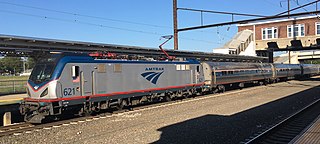
The Keystone Service is a 195 mile regional passenger train service from Amtrak between the Harrisburg Transportation Center in Harrisburg, Pennsylvania, and 30th Street Station in Philadelphia, running along the Philadelphia to Harrisburg Main Line. Most trains continue along the Northeast Corridor (NEC) to Penn Station in New York City.

The Northeast Corridor Line is a commuter rail service operated by NJ Transit between the Trenton Transit Center and New York Penn Station on Amtrak's Northeast Corridor in the United States. The service is the successor to Pennsylvania Railroad commuter trains between Trenton and New York, and is NJ Transit's busiest commuter rail service. After arrival at New York Penn Station, some trains load passengers and return to New Jersey, while others continue east to Sunnyside Yard for storage. Most servicing is done at the Morrisville Yard, at the west end of the line. The Northeast Corridor Line is colored red on NJ Transit system maps and its symbol is the State House. The Princeton Branch is a shuttle service connecting to the line. Connecting SEPTA Trenton Line service between Philadelphia and Trenton is listed in the timetable.
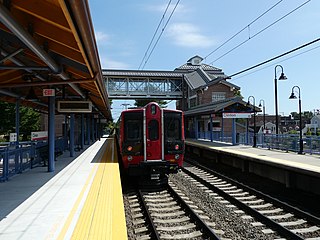
Shore Line East (SLE) is a commuter rail service which operates along the Northeast Corridor through southern Connecticut, United States. The rail service is a fully owned subsidiary of the Connecticut Department of Transportation (CTDOT) and is operated under the CT Rail brand. SLE provides service seven days a week along the Northeast Corridor between New London and New Haven; limited through service west of New Haven to Bridgeport and Stamford has been suspended since 2020. Cross-platform transfers to Metro-North Railroad New Haven Line trains are available at New Haven for service to southwestern Connecticut and New York City. Pre-COVID, around 2,200 riders used the service on weekdays.

Suburban Station is an art deco office building and underground commuter rail station in Penn Center in Philadelphia. Its official SEPTA address is 16th Street and JFK Boulevard. The station is owned and operated by SEPTA and is one of the three core Center City stations on the SEPTA Regional Rail and one of the busiest stations in the Regional Rail System.

The Shore Line Railway was a part of the New York, New Haven and Hartford Railroad system, running east from New Haven, Connecticut, to New London along the north shore of Long Island Sound. It is currently used for commuter service on ConnDOT's Shore Line East and regional/express service on Amtrak's high-speed Northeast Corridor.

The Cape Codder was a seasonal passenger train operated by Amtrak between New York City and Hyannis, Massachusetts, on Cape Cod. It operated during the summer between 1986 and 1996. It was the first regular service from New York to the Cape since 1964. The New York, New Haven and Hartford Railroad previously had operated a train under this name until 1958.

Wickford Junction station is a commuter rail station located in North Kingstown, Rhode Island, United States. It is the southern terminus of the MBTA Commuter Rail Providence/Stoughton Line and serves as a park and ride location for commuters to Providence and Boston. The station consists of a single high-level side platform on a stub-end siding next to the Northeast Corridor mainline.
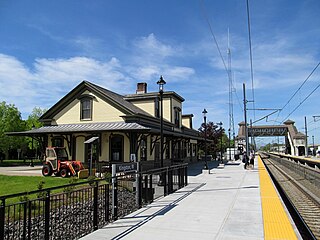
Kingston is a historic railroad station located on the Northeast Corridor in the village of West Kingston, in the town of South Kingstown, Rhode Island. It was built at this location in 1875 by the New York, Providence and Boston Railroad, replacing earlier stations dating back to the opening of the line in 1837. Current rail services consist of Northeast Regional trains in each direction, most of which stop at the station. Historically Kingston provided commuter rail service to Providence and Boston via Amtrak's commuter rail services. The MBTA is looking at extending their commuter service on the Providence/Stoughton Line.

Old Saybrook station is a regional rail station in Old Saybrook, Connecticut. It is served by both Amtrak Northeast Regional intercity trains and CTrail Shore Line East commuter service.

New London Union Station is a railroad station on the Northeast Corridor located in downtown New London, Connecticut, United States. Union Station is a station stop for most Amtrak Northeast Regional trains and all CTrail Shore Line East commuter rail trains, making it the primary railroad station in southeastern Connecticut. It serves as the centerpiece of the Regional Intermodal Transit Center, with connections to local and intercity buses as well as ferries to Long Island and Fishers Island, New York, and Block Island, Rhode Island. The station has one side platform and one island platform serving the two-track Northeast Corridor; the latter platform also serves a siding track that connects to the New England Central Railroad mainline.

Clinton station is a regional rail station served by the CTrail Shore Line East service located near downtown Clinton, Connecticut. The station has two side platforms connected by a footbridge. Clinton is a commuter-only station; Amtrak's Acela Express and Northeast Regional services run through the station without stopping.
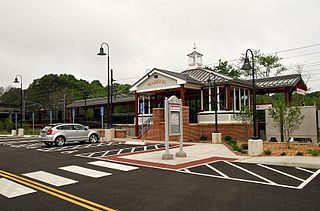
Madison is a passenger rail station along CTrail's Shore Line East commuter rail line, which runs on the Northeast Corridor between New Haven and New London. Madison station consists of a mid-sized parking lot and one high-level side platform on the southbound side of the tracks.

Guilford is a regional rail station on the Northeast Corridor, located slightly south of the town center of Guilford, Connecticut. Owned by the Connecticut Department of Transportation, it is served by the CTrail Shore Line East service.

Branford is a station along the CTrail Shore Line East commuter railroad between Stamford and New London, Connecticut. The station itself is located in Branford, Connecticut. Branford is also a station on the northern section Northeast Corridor. Amtrak does not stop at the station but Amtrak trains pass through it.
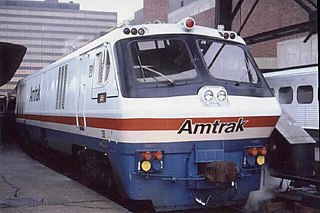
The Beacon Hill was a daily 157-mile (253 km) commuter rail service operated by Amtrak between Boston, Massachusetts, and New Haven, Connecticut, from 1978 to 1981. The Beacon Hill was one of the last long-haul commuter services operated by Amtrak. Service consisted of a single rush-hour round trip, with service eastbound to Boston in the morning and westbound to New Haven in the evening.

The Bowie Railroad Buildings comprise three small frame structures at the former Bowie train station, located at the junction of what is now the Northeast Corridor and the Pope's Creek Subdivision in the town center of Bowie, Maryland. The complex includes a single-story freight depot, a two-story interlocking tower, and an open passenger shed. The station was served by passenger trains from 1872 until 1989, when it was replaced by Bowie State station nearby. The buildings were restored in 1992 as the Bowie Railroad Museum and added to the National Register of Historic Places in 1998.

The Chesapeake was a daily passenger train operated by Amtrak along the Northeast Corridor between Washington, D.C., and Philadelphia, Pennsylvania, from 1978 to 1983. It was one of the few commuter trains operated by Amtrak.

Groton station was one of the shortest-lived Amtrak passenger rail stations, in service from January to April 1978 during the last incarnation of Amtrak's Clamdigger service. Previous stations at several locations in Groton were served from 1852 until the mid-20th century.

Niantic was a train station on the Northeast Corridor located in the Niantic village of East Lyme, Connecticut. Opened in the 1850s, it was rebuilt in 1899 and again in 1954 by the New Haven Railroad. It closed in 1972, then reopened from 1978 to 1981 for use by the Amtrak Beacon Hill. A new station has since been proposed to be built in Niantic to serve the Shore Line East commuter rail service.





















